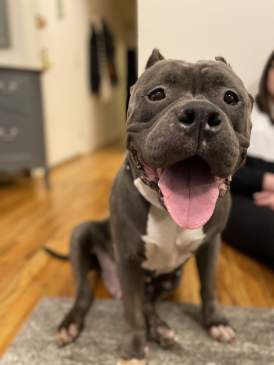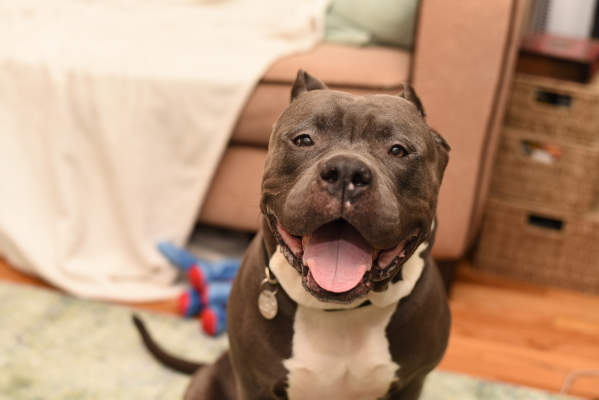The Coronavirus pandemic has disrupted nearly every aspect of normal human routine. Social distancing has especially made us conscious of our health and the health of those around us — and that includes our pets. While we're still learning about pets and COVID-19, the overwhelming evidence supports the fact that pets are not significant carriers of the disease, and in fact, do wonderful things for our mental and physical health in times of strife. And with humans spending more time than ever before in their apartments, pet fostering and adoptions have seen a spike, leaving some shelters empty for the first time. It's wonderful news in a time where there isn't much. But that's what pets do: They cheer us up.
We spoke with Anna Lai, the marketing director for Muddy Paws Rescue, a New York City-based nonprofit working to save dogs' lives, about what adoption and fostering looks like right now. How does it work? How do you meet the dogs? How do you pick the dogs up? Lai answers all your burning questions below.
What Does The Adoption/Fostering Application Process Look Like?
Every shelter operates with its own application process, and different states have different rules, so it's important to do your research before you consider adoption/fostering. Certain organizations have stringent protocols to follow before allowing you to adopt or foster, like home environment checks or financial screenings. Others use what is called an "open adoption" ethos that breaks down the barriers for people to take dogs home.
Although there are some variances in different systems, the general concept behind the application is similar. You answer general questions about your lifestyle: "How often are you out of the house? What type of work do you do? That sort of thing," explains Lai, "and this allows us to make a better match with the dogs."

Eleanor is currently up for adoption.
At Muddy Paws, which practices open adoption, that application is online and involves a follow-up call to chat through the application. Although in normal circumstances, you would see the animals soon after, the pandemic has made that increasingly harder. Shelters have moved into the virtual world (for some, for the first time) to make the process as fast, simple, and socially distanced as possible.
The application process plays a direct role in placement. "The team matches a dog with a parent based on what they've indicated during the application process. We use medical information like how big a dog is as well as what their personality is like," explains Lai. Normally, she'd ensure the new parents and dog meet before going home together, to encourage a bond and trust, but things are obviously a bit different now.
How Do You Get To Know Your Potential Dog?
While typically you'd head on down to your local shelter to get a feel for how you would interact with a pet, adopting and fostering have now become virtual meet and greets. Lai says the process is evolving every day as they get used to handling everything online, "We are trialing virtual adoption, which has gone very well... in the last two weeks, we've had over 20 adoptions." Of course, this is a good bit less than the nonprofit would be doing normally, "Typically on a regular month or a weekend where we have an adoption event, we do 20 to 30 adoptions in a day." But the progress is encouraging.
"[During Coronavirus] We are trialing virtual adoption, which has gone very well... in the last two weeks, we've had over 20 adoptions."
If you're wondering if a dog is better in a conference call than you are — don't. "They don't know where the camera is, you can't make them look. You can try!" Lai explains, but fortunately, it's not only the two of you on a very awkward Zoom call. "There's an adoption counselor on the call, talking through what the dog is like, how it would best fit in their lifestyle, if it's a good fit. They'll go through all the questions and try and showcase as much as possible what the dog is like during the virtual meeting," adds Lai.
How Do You Pick Up The Dog?
This process, again, will vary shelter to shelter, so calling or emailing ahead would be a safe bet. Outside of New York City, in places with larger driving communities, much is done by car. The shelter will organize staggered times so that there is little chance of overlap or crowding. "They can drive by the shelter, pick up their dog, and minimize the interaction," explains Lai, but things in NYC are more complicated, "We're in a very dense city, everyone's really close together, and people don't necessarily have cars. They rely on public transport. So we're figuring out ways we can apply these drive-by concepts, like an adoption van where we can go meet them with a bare bones staff."
They're constantly iterating on the processes while keeping current with social distancing guidelines, "We're still figuring it out. We need to do a trial run, make sure things run smoothly, make sure dogs remain safe, and of course, humans remain safe during the whole experience," says Lai.

Spud is also currently up for adoption
How Long Does Fostering Typically Last?
Different shelters may vary in their fostering requirements, but it's typical for fostering minimums to be put in place for the benefit of both the foster parent and the dog. "There's a two-week commitment generally for all fosters. And then after that, people typically stay with the dog until they are adopted." Long-term fosters are ultimately better for the animals, as displacing them often is less than ideal. But that shouldn't discourage people who may only have those two weeks, Lai insists, "The most important thing is that the dog is in a safe environment and has all they need to become stronger to get ready for adoption."
Any Advice For People Considering Adopting Or Fostering Right Now?
Lai has some wise words: "For adopting, really think beyond the pandemic even though it's very hard. But one day everyone will return to their regular routines and the dog will be left alone. It's so important to set your dog up for success, so make sure when you adopt, you understand you'll still need to train your dog, still need to stick to a routine. Dogs are enjoying endless human companionship, but it's very easy for a dog to take on behavior similar to separation anxiety. Give them proper exercise, proper training, so that it's not difficult when things eventually do go back to normal."
"Dogs are enjoying endless human companionship, but it's very easy for a dog to take on behavior similar to separation anxiety. Give them proper exercise, proper training, so that it's not difficult when things eventually do go back to normal."
How Else Can You Help Outside Of Fostering And Adopting?
"Currently the best way to help is donating," explains Lai, "All organizations have had their fundraising events and projects thrown out the door. Reach out to local shelters because they still have dogs in their care that need support. So if you are able to help with a donation, it really helps. It's a tough time for everyone, but if you are able to give even a dollar, it makes a difference."
If you want to help Muddy Paws specifically, you can participate in their "pawtrait for good" program. For a donation of $25, you will receive a custom digital portrait of your pet from one of these participating artists.
